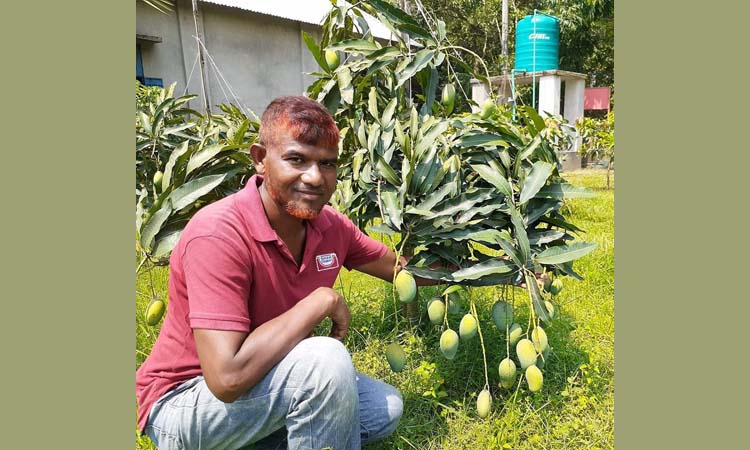
By Aynal Haque
RAJSHAHI, June 28, 2021 (BSS) - Mango farming in Ultra High Density Mango Planting (UHDMP) method has gained popularity as the growers are getting additional income after the best uses of the method in Rajshahi region, including its vast barind tract.
Sources said the modern farming system has brought a new dimension to the local economy side by side with diversifying the cropping pattern in the region.
Hefaz Uddin, 60, a resident of Bailkapara village of Nachole Upazila in Chapainawabganj, has been earning money from his land regularly through adopting the method for the last couple of years.
In 2018, he planted 100 trees of BARI-4 mango variety leaving behind the conventional variety on his one acre of land after getting an intensive training on UHDMP given on behalf of the Water Efficient Technologies to Barind Tract (IWET) project.
He got yield from 84 trees next year, fetching Taka 51,120. "I had harvested 6.7 kilograms of yield from each of the trees on an average," Hafez said with a smiling face, while talking to BSS on Sunday.
Expecting more income from his land with the application of new agricultural technology, he said the UHDM orchards are contributing a lot towards extra income giving better life to the beneficiary family members at present.
Like Hefez Uddin, many other farmers have attained economic emancipation after adopting the UHDMP method that has brought a remarkable change in the area for the last couple of years.
Dascoh Foundation and Syngenta Foundation are jointly implementing the IWET project with financial support of World Bank Group benefiting 10,000 farmers directly, while 50,000 others indirectly since 2018.
The project is being implemented in Nachole and Gomostapur Upazilas in Chapainawabganj, Tanore and Godagari Upazilas in Rajshahi and Mohadebpur and Bodolgachhi Upazilas in Naogaon districts.
With intervention of the scheme, 10,000 farmers, including 6,000 on UHDMP and 4,000 on Adoption of Alternate Drying and Wetting (AWD) irrigation technology were given training.
Project Manager Shohidul Islam told BSS that 110 demonstration plots have, so far, been developed on 8.9 hectares of land with 15,333 trees in the project covering areas.
The project is intended to achieving significant farm productivity in a sustainable manner by introducing efficient irrigation and other relevant technologies and management practices.
Hefez Uddin said new mango orchards, especially of Amrapali, BARI mango-3 and 4 varieties are rapidly increasing in the districts every year.
While the traditional larger trees take eight to nine years to bear fruit, the UHDMP method's smaller trees produce fruit within two to three years.
The smaller varieties are gaining popularity as more trees can be planted on the same piece of land and their harvest time is shorter, he added.
Normally 10 mango trees are planted in one bigha of land, but in the new farming method, farmers can plant up to 200 trees in the same space, said Ismail Hossain, a mango grower of Komorpur village in Godagari upazila of Rajshahi.
Project Manager Shohidul Islam said the critical components of UHDMP technology are the management of inputs related to irrigation and fertiliser and the canopy management. These two inputs are provided through drip irrigation systems.
Pruning is a very essential and critical operation of UHDP to maintain fruiting shoots and to contain its canopy. It must be done soon after harvest, preferably before 15 June.
He said: “About a month after pruning, thinning of the newly emerged shoots is essential in order to avoid excess ones and overcrowding.”
He said it increases productivity up to 2-3 times, reduces water used for irrigation up to 50 per cent and increases fertiliser intake by plants.